Publications - Published papers
Please find below publications of our group. Currently, we list 565 papers. Some of the publications are in collaboration with the group of Sonja Prohaska and are also listed in the publication list for her individual group. Access to published papers ( ) is restricted to our local network and chosen collaborators.
If you have problems accessing electronic information, please let us know:
) is restricted to our local network and chosen collaborators.
If you have problems accessing electronic information, please let us know:
 ) is restricted to our local network and chosen collaborators.
If you have problems accessing electronic information, please let us know:
) is restricted to our local network and chosen collaborators.
If you have problems accessing electronic information, please let us know:©NOTICE: All papers are copyrighted by the authors; If you would like to use all or a portion of any paper, please contact the author.
Translation in Mammalian Mitochondria: Order and Disorder Linked to tRNAs and Aminoacyl-tRNA Synthetases
Catherine Florentz, Joern Pütz, Frank Jühling, Hagen Schwenzer, Peter F. Stadler, Bernard Lorber, Claude Sauter, Marie Sissler
Download
PREPRINT 13-014:
Status: Published
In: Anne-Marie Duchene, editor, Translation in Mitochondria and Other Organelles , pages 55–85. Springer, Heidelberg, 2013
Abstract
Transfer RNAs (tRNAs) and aminoacyl-tRNA synthetases (aaRSs) are key actors in all translation machineries. AaRSs aminoacylate cognate tRNAs with a specific amino acid that is transferred to the growing protein chain on the ribosome. Mammalian mitochondria possess their own translation machinery for the synthesis of 13 proteins only, all subunits of the respiratory chain complexes involved in the synthesis of ATP. While 22 tRNAs and two ribosomal RNAs are also coded by the mitochondrial genome, aaRSs are nuclear encoded and become imported. The fact that the two cellular genomes, nuclear and mitochondrial, evolve at different rates raises numerous questions as to the co-evolution of partner macromolecules. Herein we review the present state-of-the-art on structural, biophysical, and functional peculiarities of mammalian mitochondrial tRNAs and aaRSs, and of their partnership in their wild-type state. Then, we oppose this mitochondrial “order” to the “disorder” generated by the presence of a variety of mutations occurring in the corresponding human genes that have been correlated to an increasing number of diseases. So far, more than 230 mutations in mitochondrial tRNA genes and a rapidly growing number of mutations in mitochondrial aaRS genes have been reported as causative of a large variety of pathologies. The molecular incidence of mutations on structural, biophysical and functional properties of the related macromolecules will be summarized. Mutations in mitochondrial tRNA genes lead to complex mosaic effects with a major impact on tRNA structure. Some mutations affecting mitochondrial aaRS genes do not interfere with the housekeeping aminoacylation activity, suggesting that mitochondrial aaRSs, alike cytosolic aaRSs are involved in other processes than translation. This opens new research lines.















